| |
 |
Clarksville |
Indiana |
USA |
horizontal dial |
Dial 1112 |
| This is a round,stone sundial 48-inches (122cm) in diameter with a plain triangular gnomon. The chapter ring has Roman hours etched from 5am to 7pm, delineated in quarter hours. The dial sits 8-inches (20cm) above a 60-inch (152cm) wide concrete base. Official town records show that this dial was donated to the town of Clarksville to commemorate the country's Bicentennial in 1976. The inscription says the dial was dedicated to George Rogers Clark, the town’s founder and a Revolutionary War hero. He was the brother of William Clark of “Lewis & Clark Expedition” fame. |
| |
| |
 |
Ogunquit |
Maine |
USA |
Horizontal Dial |
Dial 1111 |
| This is an elegant commercially made bronze horizontal dial about 18-inch (.46 cm) in diameter. The Chapter Ring has hours from 5am to 7pm, divided in quarter hours. Hours are marked in Roman Numerals from VI to VI. A bird sits profile in the gnomon, filling the space beneath the style. The gnomon foot is accurately placed to a line between VI-VI, but the gnomon angle was not measured. The dial rests on a polished brown granite pillar. At the base of the pillar is a small bronze plaque. |
| |
| |
 |
Georgetown |
Ohio |
USA |
Horizontal Dial |
Dial 1110 |
| This is a large commercial bronze horizontal dial set at ground level on a circular concrete pad. The dial is embossed with Roman hours in a chapter ring and delineated for quarter hours. The inscription circles the dial in an outer rim. The gnomon is standard with a bird beneath the style. However the gnomon is set about 2 inches (5cm) north of the VI-VI line. It may not matter as the dial appears to be under a tree. |
| |
| |
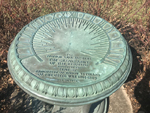 |
Hamilton |
Ohio |
USA |
Horizontal Dial |
Dial 1109 |
| This is one of a series of bronze sundials presented by Daughters of Union Veterans of the Civil War, dedicated to the memory of the Grand Army of the Republic. This dial is 24 inches in diameter, with an ornate design of ovals at the exterior, sloping down to 30 inches in diameter. Hours are marked from 5am to 7pm in Roman numerals. Time is marked in quarter hours. Unfortunately the gnomon has long been missing. |
| |
| |
 |
Rockville |
Maryland |
USA |
Reflective Equatorial |
Dial 1108 |
| One of Bill Gottesman's unique-design Renaissance dials of cast and structural bronze with a 27 inch diameter helix with a celestial-north aligned axis. Time is told by a focused beam of light that moves around the helix throughout the day. The light beam is reflected from a long cylindrical unsilvered mirror in a structure that supports the helix. A sliding time scale within the helix can be adjusted for EOT and DST and includes longitude correction. Once this scale is adjusted for date, the dial shows civil, or clock, time. The dial base is cast bronze allowing adjustment for latitude and placed on a concrete pedestal with a black granite plinth. |
| |
| |
 |
Early |
Texas |
USA |
Horizontal Dial |
Dial 1107 |
| This is a monumental sundial with a gnomon is 52 feet (16m) long and 24 feet (7.3m) tall at the point. Tall concrete pillars mark the hours from 7am to 5pm in an offset circle 60 feet (18m) in diameter. The 7:00am/5:00pm pillars are 7 feet (2.1m) tall, and stair-step in height 1 foot (0.3m) for each hour until the noon pillar at 12 feet (4m) tall. The pillars are asymmetrically arranged to accommodate the longitude offset from Central Standard Time at 90° longitude. The pillars are set at the outer edge of a 6 foot (2m) concrete walkway and back lit by LEDs at night. Directly under the tip of the gnomon are brass cardinal direction letters, memorial bricks and a rock garden, under which a time capsule has been buried to be opened on the city's 100th birthday. At night, LED lights in gnomon cut-outs show stars, the moon, and planets. There is a plaque in front of each pillar showing who made the donation for that particular pillar. Memorial bricks were another fundraiser. Around $107k in donations was raised in addition to grants from the city for the sundial project. |
| |
| |
 |
Ottawa |
Ontario |
Canada |
Vertical Dial |
Dial 1106 |
| A 1.2m (47 in) wide by 0.7m (28 in) high vertical sundial that declines 5 degrees to the west of south. Hour lines are longitude-corrected. The dial face was laser cut from a large 3mm (1/8 in) thick plate of steel and powder coated with white paint. The cut-out pieces of the steel sheet were beautifully assembled together and mounted near the front door of the house. A conic gnomon was selected to point to the hour lines from 9am to 6pm summer hours. |
| |
| |
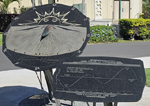 |
Laie |
Hawaii |
USA |
Vertical Dial |
Dial 1105 |
| To accommodate Hawaii's low latitude, this is a reclining sundial more than a meter (3 feet) in diameter and stands over 2 meters (6 feet) tall. It is carved from a dark, igneous stone with a bronze conical gnomon and set on bronze legs. The sundial includes a separate, stone-carved legend that includes an explanation of how to correct the gnomon shadow-time indicated on the dial for the time of year. The sundial, taken as a whole is reminiscent of a bird, enhanced by the conical gnomon and sun on the horizon given two eyes. At the edge of the dial are symbols of the zodiac |
| |
| |
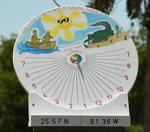 |
Naples |
Florida |
USA |
Equatorial Dial |
Dial 1104 |
| A whimsical equatorial dial set on a pole. The solid dial face has a drawing of canoeists opposite an alligator with its mouth open and.above them is a smiling sun wearing sunglasses. Time on the summer side is from 6:30am to 7:30pm while on the winter side, time is delineated from 7am to 7pm.(but still using daylight saving time). Both sides have mean solar time adjusted for longitude, about 24 minutes.. |
| |
| |
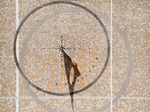 |
Salem |
Oregon |
USA |
Vertical Dial |
Dial 1103 |
| This vertical declining sundial is form with small squares of tile, showing the hours within a dark grey circle of tiles. The hours are marked by long orange-tile hour lines while the half-hours are marked by two dark grey tiles. A secondary circle of light grey adorns the wall, showing the length of the shadows and making the dial aesthetically pleasing. The background tiles are porcelain in common designer colors. The gnomon is a substantial stainless steel shape formed with a hole and curving points on the downward side, allowing leaves and small branches to slide off. |
| |
| |
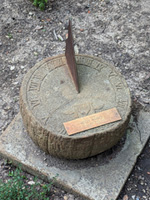 |
Westerville |
Ohio |
USA |
Horizontal Dial |
Dial 1102 |
| This horizontal dial is of weathered concrete, about 38cm (15 inches) in diameter. Roman numerals mark the hours from 5am to 7pm. A large bronze gnomon with foot in the center of the round dial casts the shadow. The north edge of the gnomon is shaped into a face. The garden includes a traditional knot garden, a water feature, and a unique sundial made of herbs. |
| |
| |
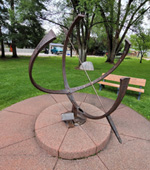 |
Carbondale |
Colorado |
USA |
Equatorial Dial |
Dial 1101 |
| This equatorial is of hammered wrought iron about 2m (6 ft) in diameter with fluted ends on both the equatorial and meridian arcs. Time is shown from 4am to 8pm with small brass hour marks engraved with Roman numerals. Time is offset for the longitude correction. Brass cardinal directions are set into the iron based |
| |
| |
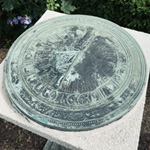 |
Halifax |
Nova Scotia |
Canada |
Horizontal Dial |
Dial 1100 |
| A bronze horizontal dial 36cm (14 in) in diameter with chapter ring of Roman numeral hours from V (am) to VII (pm). Hours are delineated in quarter hours and extend from 4am to 8pm (unmarked). Noon is designated by an "O". Gnomon has the inset profile of a bird. At south is father time with a scythe. The conglomerate pedestal is slowly disintegrating. |
| |
| |
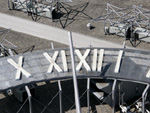 |
Vancouver |
British Columbia |
Canada |
Horizontal Dial |
Dial 1099 |
| This is intended to be a horizontal sundial, but positioned poorly and viewed by nearly no one.. The chapter ring is marked out in Roman numerals running from V (am) to IV (pm) on a large semi-circular arc of open metalwork supported by a trellis structure. It is very large, about 40 meters across. The gnomon is a separate structure and is not positioned or oriented correctly. |
| |
| |
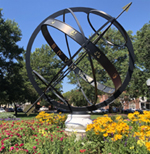 |
Pella |
Iowa |
USA |
Armillary Sphere |
Dial 1098 |
| An elegant armillary sphere approximately 8 ft (2.5m) tall. Painted black with gold Roman numerals for the hour marks. On the outside of the equatorial ring at each hour are embossed zodiac figures The gnomon is a traditional arrow with gold tip and feather. The dial has traditional arctic and antarctic rings. |
| |
| |
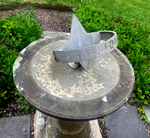 |
Dedham |
Massachusetts |
USA |
Digital Dial |
Dial 1097 |
| This is one of John Garret Thew's mass produced "digital sundials" patented on April 5, 1960. The dial casts a numeral onto the dial's central plate that accommodates beams of sunlight and shadow from winter to summer solstice. The numerals (corrected for the hour angle distortion) slowly move across the dial's plate and the hour is read at the meridian line. Perhaps a good selection for advanced technology at MIT to grace their garden, but it has been neglected in recent years. However, Thew was not the first to come up with this digital sundial. In June 1758 Monsieur De Lalande of the Royal Academy of Sciences in a letter to the editors of the Journal des Scavans described a dial by J.L. Bizot (1702-1781) in which, on an internal wall, an angel's hand is raised to point upward at numerals of light cast "by a half-ring of iron...which has small openings every 15 degrees in the form of a numeral..." |
| |
| |
 |
Ann Arbor |
Michigan |
USA |
Noon Mark or Meridian Dial |
Dial 1096 |
| Dial is a calendar dial that marks noon on the solstices and equinoxes by projecting a circle of sunlight onto one of three horizontal discs on the meridian line dial face. To create the round sunlight spots the vertical arm has three elliptical holes to match the solar angles for the two solstices and the equinox. The disk closest to the gnomon (with highest solar angle) is for the summer solstice. Middle disk is for the equinoxes, and the farthest disk (with lowest solar angle) is for the winter solstice. Notice in the photo that the summer hole in the vertical arm is considerably stretched to account for the high angle of the sun. |
| |
| |
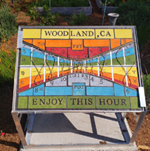 |
Woodland |
California |
USA |
Polar Dial |
Dial 1095 |
| It is a polar dial using a rod gnomon. Using a template from Shadows software, the dial is made of handmade ceramic tiles mounted on an aluminum bar frame anchored to a concrete base. Brass borders define winter and summer solstice declination lines, and an aluminum bar defines the E-W equinox declination. Copper analemmas define the sun’s annual path at 7:30/8:30 PST/PDT and hourly until 5/6PM. Metal balls along the analemmas are placed the 1st of each month. Black declination lines mark the ancient Babylonian Zodiacal signs, designated by different colors. Hours are numbered for PST and PDT. Standard time on the hour, accurate to 1 minute, is read on the tile surface when the gnomon shadow is just under the analemma for that hour. The 1st of each month is marked on tiles in early AM and late PM hours, guiding which side of the analemma is used. |
| |
| |
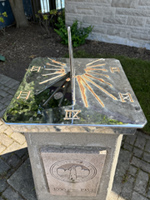 |
Southampton |
Ontario |
Canada |
Horizontal Dial |
Dial 1094 |
| A simple horizontal dial marked with solar hours, unusual in having a reflective chrome coating of the entire dial (in some spots the chrome has flaked off where the underlying material has started to rust). The gnomon is a triangular vane with a pattern of round holes pierced though it. The dial face is approximately 20" (50cm) square and wraps down at the edges to make a 3" (7.5cm) high block. It stands on a square concrete column about 3' (1m) high, which also contains a hidden Time Capsule. |
| |
| |
 |
Oxford |
Michigan |
USA |
Armillary Sphere |
Dial 1093 |
| This is an armillary of unusual construction, mostly of nicely prepared wood. The base has three legs set out at 120°, holding horizon ring approximately 1m (39 inches) in diameter. An adjustable meridian ring for any latitude holds a brass polar axis rod and a cylinder for reading various time scales. The horizon ring has azimuths marked at every 5° and labelled every 15°. Interior to the horizon ring is the earth's celestial equator marked in right ascension in both hours and degrees. The equatorial ring ais connected to an umbrella-like portion of the north celestial pole, showing the position of the Big Dipper and Polaris. |
| |
| |
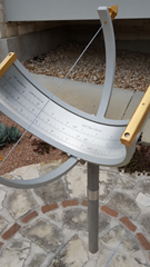 |
Georgetown |
Texas |
USA |
Equatorial Dial |
Dial 1092 |
| A brilliant equatorial dial, constructed of stainless steel, aluminum, and gold-plated brass. Scales for local apparent time, Central Standard time, and Central Daylight time where the Equation of Time on a plaque fixed to the meridian circle. Dial mounting incorporates a unique gimbal to allow precise adjustment of N-S alignment and a meridian ring clamp with plate that mounts to the pedestal pole using adjustment bolts. |
| |
| |
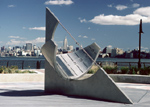 |
Jersey City |
New Jersey |
USA |
Equatorial Dial |
Dial 1091 |
| The equatorial sundial is a classic "bow string" sundial using a thin rod with a nodus to tell both time and date. The nodus is a small disk with a hole in the center to let a beam of sunlight fall near the noon hour line on the equatorial ring. The equatorial ring (a semi-circle) as the rest of the dial is stainless steel, The dial is 12 feet (4m) at the base and 12 feet (4m) in height, forming a 45 deg triangle in profile. |
| |
| |
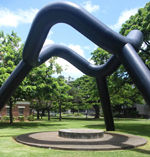 |
Honolulu |
Hawaii |
USA |
Sun Alignment |
Dial 1090 |
| "Sky Gate" is a huge 24 foot (7.3m) undulating sculpture of black metal is known as one of Honolulu's most distinctive pieces of public art. There is a hidden astronomical alignment. On zenith days (~28 May and ~18 July) when the sun is directly overhead at the zenith at the moment of local solar noon, the shadow of the sculpture forms a perfect, large circle on the ground directly below. The zenith day noon is known as "Lāhainā Noon", a term coined by the Bishop Museum, and in Hawaiian means "Cruel Sun". Noguchi, the sculptor, didn't leave a plaque, but Tory Laitila, registrar at the Mayor’s Office of Culture and the Arts, says, "Art is a subjective experience, and artists like to leave things for the viewer to discover." Now the Lāhainā Noon is well known and there is usually a crowd with cameras to document this twice annual event. |
| |
| |
 |
Addison |
Texas |
USA |
Sun Alignment |
Dial 1089 |
| This is a sun alignment arch about 23 feet (7m) high and 650 feet (20m) in length and 5 foot (1.5m) wide, It is made of Corten steel, a metal whose surface oxidizes quickly, leaving a rusty chocolate color that provides a textured surface. The archAt the top of the arch are keystone wedges that funnel sunlight on the equinox at local solar noon onto a steel sphere on the ground below. The original model for the arch was made in bronze in 1974 and titled “Rainbow arch restructured”. |
| |
| |
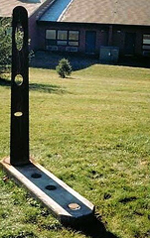 |
Ann Arbor |
Michigan |
USA |
Noon Mark or Meridian Dial |
Dial 1088 |
| Dial is a calendar dial that marks noon on the solstices and equinoxes by projecting a circle of sunlight onto one of three horizontal discs on the meridian line dial face. To create the round sunlight spots the vertical arm has three elliptical holes to match the solar angles for the two solstices and the equinox. The disk closest to the gnomon (with highest solar angle) is for the summer solstice. Middle disk is for the equinoxes, and the farthest disk (with lowest solar angle) is for the winter solstice. Notice in the photo that the summer hole in the vertical arm is considerably stretched to account for the high angle of the sun. |
| |
| |
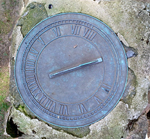 |
Ann Arbor |
Michigan |
USA |
Horizontal Dial |
Dial 1087 |
| This horizontal brass dial is 16-inch (40.6cm) in diameter. A chapter ring holds hours marks in Roman numerals from 4am to 8pm, and includes 10 minute marks at the outer edge of the ring. The dial is plain with no inscription. The gnomon is broken off at the face of the dial. The dial is a placed on an irregular stone mount with two concrete blocks with the name Chubb and Sessions, whose family graves surround the sundial memorial. |
| |
| |
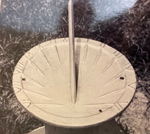 |
Ypsilanti |
Michigan |
USA |
Horizontal Dial |
Dial 1086 |
| This is the original horizontal dial and gnomon of 1909, cast in iron as a gift from the Class of 1908 (then known as the Michigan State Normal School ). This sundial was originally located on the west side of the sidewalk coming from the main south entrance of Serzer Observatory on the Eastern Michigan University campus, now the location of the EMU "Sesquicentennial Sundial". [See NASS Dial #346] This original dial is about 12 inches (30cm) with Roman hour marks from 6am to 6pm on the edge of the dial. Hour lines extend from the edge to about half way to the gnomon foot. |
| |
| |
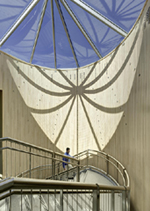 |
Ann Arbor |
Michigan |
USA |
Cylindrical Dial |
Dial 1085 |
| The dial is inscribed on a 20-ft (6m) diameter stairwell creating a very large cylindrical altitude sundial. The nodus is the center of the skylight directly above the circular stair well. Hours are marked at the top of the dial in Arabic numerals. Hour lines are a series of dots extending down the wall. A display near the dial explains how it functions. |
| |
| |
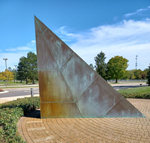 |
Ann Arbor |
Michigan |
USA |
Horizontal Dial |
Dial 1084 |
| This is a large monumental scale horizontal sundial. The gnomon, approximately 15-ft (4.5m) high has a brass patina and made using polygonal segments assembled almost in jigsaw puzzle style to form a large triangle. The gnomon sits at the north end of a large 30-ft (9.1m) brick plaza, wasting the area of the plaza except for a large imbedded brass plaque. Hours are simply marked by light colored granite with a pointed exterior aimed toward the edge of the plaza. Harder to see are half-hour light colored small granite triangles. |
| |
| |
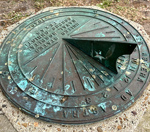 |
Corpus Christi |
Texas |
USA |
Horizontal Dial |
Dial 1083 |
| Farenholt sundial for U.S. Naval Hospital Corpus Christi Texas. This cast bronze dial was designed and commissioned by RADM Farenholt for U.S. Naval Hospitals at bases where he was commanding officer, visited, or had special meaning to him. The dial is 18 inches (46cm) in diameter. The outer chapter ring has the motto, followed by a chapter ring with Arabic hours 6am to 6pm, raised hour lines that radiate from near the foot of the gnomon and short half-hour lines. The gnomon has graceful curves and a star cut-out in the center. Below the gnomon is the naval command name, followed by the commissioning date in the southern portion of the hours chapter ring. |
| |
| |
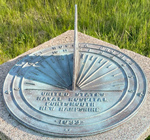 |
Portsmouth |
New Hampshire |
USA |
Horizontal Dial |
Dial 1082 |
| Farenholt sundial for U.S. Naval Hospital Portsmouth New Hampshire. This cast bronze dial was designed and commissioned by RADM Farenholt for U.S. Naval Hospitals at bases where he was commanding officer, visited, or had special meaning to him. The dial is 18 inches (46cm) in diameter. The outer chapter ring has the motto, followed by a chapter ring with Arabic hours 6am to 6pm, raised hour lines that radiate from near the foot of the gnomon and short half-hour lines. The gnomon has graceful curves and a star cut-out in the center. Below the gnomon is the naval command name, followed by the commissioning date in the southern portion of the hours chapter ring. |
| |
| |
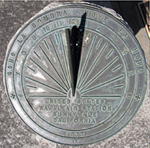 |
Sunnyvale |
California |
USA |
Horizontal Dial |
Dial 1081 |
| Farenholt sundial for U.S. Naval Air Station Sunnyvale CA. This cast bronze dial was designed and commissioned by RADM Farenholt for U.S. Naval Hospitals at bases where he was commanding officer, visited, or had special meaning to him. The dial is 18 inches (46cm) in diameter. The outer chapter ring has the motto, followed by a chapter ring with Arabic hours 6am to 6pm, raised hour lines that radiate from near the foot of the gnomon and short half-hour lines. The gnomon has graceful curves and a star cut-out in the center. Below the gnomon is the naval command name, followed by the commissioning date in the southern portion of the hours chapter ring. |
| |
| |
 |
Hawthorne |
Nevada |
USA |
Horizontal Dial |
Dial 1080 |
| Farenholt sundial for U.S. Naval Ammunition Depot Hawthorne Nevada. This cast bronze dial was designed and commissioned by RADM Farenholt for U.S. Naval Hospitals at bases where he was commanding officer, visited, or had special meaning to him. The dial is 18 inches (46cm) in diameter. The outer chapter ring has the motto, followed by a chapter ring with Arabic hours 6am to 6pm, raised hour lines that radiate from near the foot of the gnomon and short half-hour lines. The gnomon has graceful curves and a star cut-out in the center. Below the gnomon is the naval command name, followed by the commissioning date in the southern portion of the hours chapter ring. |
| |
| |
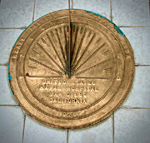 |
San Diego |
California |
USA |
Horizontal Dial |
Dial 1079 |
| Farenholt sundial for U.S. Naval Hospital San Diego California. This cast bronze dial was designed and commissioned by RADM Farenholt for U.S. Naval Hospitals at bases where he was commanding officer, visited, or had special meaning to him. The dial is 18 inches (46cm) in diameter. The outer chapter ring has the motto, followed by a chapter ring with Arabic hours 6am to 6pm, raised hour lines that radiate from near the foot of the gnomon and short half-hour lines. The gnomon has graceful curves original had a trefoil cut-out in the center. The restored gnomon has an irregular cut-out based on a photo of the original gnomon's shadow. Below the gnomon is the naval command name, followed by the commissioning date in the southern portion of the hours chapter ring. Dial has been restored, now having a gold luster. |
| |
| |
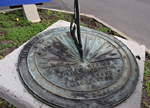 |
Bremerton |
Washington |
USA |
Horizontal Dial |
Dial 1078 |
| Farenholt sundial for U.S. Naval Hospital Puget Sound Washington. This cast bronze dial was designed and commissioned by RADM Farenholt for U.S. Naval Hospitals at bases where he was commanding officer, visited, or had special meaning to him. The dial is 18 inches (46cm) in diameter. The outer chapter ring has the motto, followed by a chapter ring with Arabic hours 6am to 6pm, raised hour lines that radiate from near the foot of the gnomon and short half-hour lines. The gnomon has graceful curves and a trefoil cut-out in the center. Below the gnomon is the naval command name, followed by the commissioning date in the southern portion of the hours chapter ring. |
| |
| |
 |
Newport |
Rhode Island |
USA |
Horizontal Dial |
Dial 1077 |
| Farenholt sundial for U.S. Naval Hospital Newport Rhode Island. This cast bronze dial was designed and commissioned by RADM Farenholt for U.S. Naval Hospitals at bases where he was commanding officer, visited, or had special meaning to him. The dial is 18 inches (46cm) in diameter. The outer chapter ring has the motto, followed by a chapter ring with Arabic hours 6am to 6pm, raised hour lines that radiate from near the foot of the gnomon and short half-hour lines. The gnomon has graceful curves and a quatrefoil cut-out in the center. Below the gnomon is the naval command name, followed by the commissioning date in the southern portion of the hours chapter ring. Dial sits atop a circular stone pedestal with beveled capital. |
| |
| |
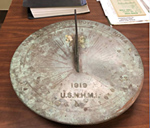 |
Mare Island |
California |
USA |
Horizontal Dial |
Dial 1076 |
| Farenholt sundial for U.S. Naval Hospital Mare Island. Cast bronze, 18 inch (46 cm) diameter circular face, mounted on a cement pedestal 40 inches tall. Only three Farenholt sundials are known to have Spanish mottos: Mare Island is one of them. (Sunnyvale, CA and Hawthorne, NV are the others). We notice other difference from the classic Farenholt sundial: (1) there is no true chapter ring for the hour marks. They are at the end of long hour lines that extend from 4am to 8pm. All other dials are from 6am to 6pm. (2) The hours are delineated in quarter hours. All other dials are delineated in half hours. (3) The gnomon foot is considerably below center (and appears restored) with a raised style edge that is more “art deco” than the curves of other Farenholt gnomons. (4) The naval command is not spelled out. Rather, just the initials “U.S.N.H.M.I”. All other Farenholt dials spell the naval command in full. (5) The date is placed above the command initials. All other dials have the date below the naval command title. (6) There are no Farenholt initials on the dial’s southern edge. All of this may indicate the haste with which the dial was made, perhaps to memorialize those that died in Vallejo due to the 1918-1919 influenza epidemic. |
| |
| |
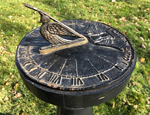 |
Lombard |
Illinois |
USA |
Horizontal Dial |
Dial 1075 |
| Classic black cast iron sundial 9.5 inches (24 cm) in diameter. Chapter ring with Roman numerals 5am - 7pm. Delineated with notches every fifteen minutes. Cast iron gnomon with bird interior, painted as brass. No noon gap for the half-inch (1.25 cm) thick gnomon. The original red oak wood pedestal was rebuilt in the summer of 2022. For added durability the pedestal was finished with several coats of Epifanes Yacht Enamel |
| |
| |
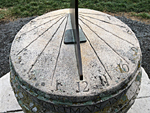 |
Spokane |
Washington |
USA |
Horizontal Dial |
Dial 1074 |
| The stone dial is approximately 24 inches (61 cm) in diameter with a large brass gnomon whose foot is considerably offset to the south. Simple hour lines with Arabic numbers from 7am to 5pm facing outward. The dial is approximately 2 inches (5 cm) thick with a band for inscription directly below. All this sits on a 12-sided pedestal of slightly larger diameter. On each slender side of the pedestal is an embossed sign of the zodiac. Lichens have taken hold on parts of the dial and pedestal. The sundial is a memorial to the two sons of Mr. and Mrs. R. Jackson Wortman. Jacob J. Wortman died at age 15 after a lingering illness. Ward K. Wortman, a fighter pilot in the Air Corps, was killed in action. |
| |
| |
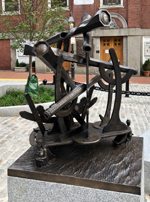 |
Boston |
Massachusetts |
USA |
Sculpture/Artwork |
Dial 1073 |
| The sundial is at the base of a larger sculpture, "Fantastical Historical Nautical Instrument" which includes many references to maritime history, navigation, and time keeping. The cast bronze dial plate is 7 inches (18 cm) in diameter, given a dark patina. The dial has what appears to be correctly delineated to tell local solar time. Roman numerals show between the hour marks and time is marked at 5-minute intervals. At center is a compass rose with 16 points of labelled directions. At the south end of the dial is a graphical equation of time. The gnomon is only partially correct with the majority distorted into an upright support for the fantastical nautical instruments and telescope representations above it. A portion of the gnomon may tell time during the hours around noon, but then the dial is overwhelmed by shadows not of its own. Treat this as part of a sculpture and enjoy the art. |
| |
| |
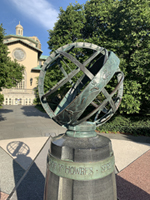 |
Brooklyn |
New York |
USA |
Armillary Sphere |
Dial 1072 |
| This is a bronze armillary sphere approximate 3 feet (1 m) in diameter with a wide equatorial band decorated on the outside with animals of the zodiac. On the inside are large Roman numerals with marks on the quarter hour. The dial is adjusted for longitude and beneath is a graph of the Equation of Time. The sphere is has the tropic of Cancer and Tropic of Capricorn circles for the limits of solar declination and arctic/antarctic circles for 24-hour sunlight. The meridian circle is decorated with arrow spikes. An inscription band circles the stone plinth. The whole dial sets in a plaza designed with a large compass rose. |
| |
| |
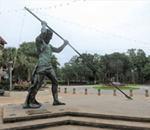 |
Hilton Head |
South Carolina |
USA |
Horizontal Dial |
Dial 1071 |
| A self-proclaimed "World's Largest Figurative Sundial" centers on a 12 foot (3.6m), 3000 pound (1360 kg) statue of Neptune. His trident, set at an angle of 32 degrees, serves as the gnomon. This massive structure sits on a low dais 26 feet (8m) in diameter, surrounded by low octagonal steps. Neptune is an impressive sculpture by Wayne Edwards. But the hour lines are a disaster. "Edwards enlisted the help of experts Frank Yerkes and Richard Hamilton of the engineering firm Sea Island Engineering, now known as Sea Island Land Survey, LLC" They could find north (and there is an "N" in the chapter ring indicating true north, but regardless of the story about sighting Polaris, the noon mark is aligned -8 degrees to the west, pointing to magnetic north). More serious is the marking of hour lines from IV (am) to VIII (pm). The VI hour lines are opposite, but drawn to the center of the dais that is easily 9 feet (3m) from the base of the trident gnomon where they belong. This great structure will never tell solar time. |
| |
| |
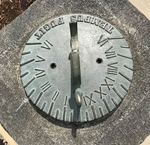 |
Mendota Heights |
Minnesota |
USA |
Horizontal Dial |
Dial 1070 |
| This brass horizontal sundial was donated to the school in or around 1908 by the Visitation School class of 1908. It was moved from St. Paul MN to Mendota Heights, MN in 1966 when the school was relocated. In the spring of 2018 it was moved to a protected garden, but sits on the original 1908 pedestal 3 foot (1m) tall and 18 inches (46cm) square. The original dedication engraved into the pedestal is still plainly visible. The dial itself is approximately 12 inches ( 30 cm) in diameter with raised hour lines on the circumference and raised Roman numeral hour marks on the interior from 6am to 6pm. The dial is in excellent condition, but in 2017 a new brass gnomon was cast as a replacement for the missing simple triangular gnomon. The new 1 inch (2.5 cm) wide gnomon is in the shape of a crescent moon. Although aligned with the noon line, this gnomon will never cast a shadow. telling correct time. It is sad that this 114 year old sundial has been reduced to nothing more than an artistic sculpture. |
| |
| |
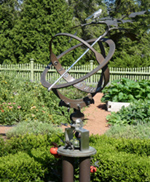 |
Nashville |
Tennessee |
USA |
Armillary Sphere |
Dial 1069 |
| This armillary sphere is based on a Chinese design with an equatorial ring containing Arabic hour marks but the meridian ring exists only below a longitudinal ring set to the dial's latitude. The dial presents Tennessee's identity and is dedicated to the school children of Tennessee. 4 copper columns support the dial, honoring the Greek and Roman tradition of placing a sundial in the center of a garden. The capital and base are cast bronze and the foundation is Tennessee crab orchard limestone. Surrounding the base are 5 tomato plants, the State fruit. 3 are enameled red to represent the three stars in the State flag. Sitting on the base is the eastern box turtle, State reptile. Branches from a tulip poplar, the State tree, extend from the north end of the gnomon and a mockingbird, the State bird, sits in the branches. The branches are made of forged bronze and the leaves are copper, cut by hand, then repousséd or shaped by hammering on the reverse side, then enameled. The mockingbird is made of raised and repousséd copper with enamel for color. The legs are bronze for strength. |
| |
| |
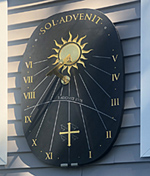 |
White Plains |
New York |
USA |
Vertical Dial |
Dial 1068 |
| This vertical dial is a "super ellipse" 36 x 12 inches (92 x61 cm). It is made of dark slate 1.2 inches (3 cm) thick with a stainless steel backing. Hour lines are in grey, radiating from a gilt flaming sunburst. With the dial declining 7 deg to east, Roman hour marks in gilt range 6AM to 5PM (noon is absent for a crest), with dots for half hours. The gnomon is 3mm brass with a nodus disk parallel to the plane of the dial. No solstice nor equinox lines, but a dateline of 5 August, 1978 (wedding anniversary). |
| |
| |
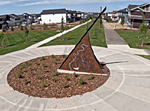 |
Edmonton |
Alberta |
Canada |
Horizontal Dial |
Dial 1067 |
| This horizontal sundial has a steel gnomon and extended rod to cast shadows onto a large, circular dial plaza 18m in diameter. The plaza has inlaid bronze cardinal markers, hour line separations in the concrete, and bronze inlaid Roman numerals from 5AM to 10PM. Wild roses, the official flower of Alberta, are planted in the center of the plaza surrounding the gnomon. The gnomon itself is 5.85m long |
| |
| |
 |
Milwaukee |
Wisconsin |
USA |
Analemmatic Dial |
Dial 1066 |
| A large analemmatic ("human") sundial with bronze zodiac walkway and Arabic hour numbers. The dial also has a simple 4-point compass rose. The Horticulturalists had asked that an area of interest be created in the paved area in front of the school bus load zone. A durable and permanent solution was requested which resulted in the analemmatic dial with cast bronze numerals and a zodiac walkway cast in two pieces. Douglas Hunt, a scientist in Scotland determined the layout of the numeral locations and dates of the zodiac walkway. The site work was designed by County staff engineer Julie Bastin and Ruvin Bros construction completed the installation. |
| |
| |
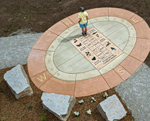 |
Janesville |
Wisconsin |
USA |
Analemmatic Dial |
Dial 1065 |
| This 21 ft x 16 ft (7m x 5m) analemmatic sundial has a landscaped area with seating and a stone pier that holds a bronze dedication plaque and a bronze information plaque with a QR code for additional online information. The central zodiac walkway is a 2,500 pound pre-cast concrete slab that includes images of regional plants and animals next to their corresponding months to represent seasonal cycles as a reminder that nearly all life on earth is connected to the relative motions and positions of the sun and earth. The bronze hour numerals and bronze cardinal point letters are anchored into poured concrete rings that surround the walkway. The analemmatic sundial is modeled after the one at the Milwaukee County Botanical Domes. |
| |
| |
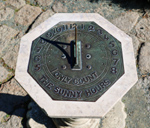 |
Berkeley |
California |
USA |
Horizontal Dial |
Dial 1064 |
| A 10 3/4 inch (27.3 cm) octagonal bronze horizontal dial is fixed to a marble tablet and rests on a thin pedestal for a total height of 32 inches (81.3 cm). Gnomon is badly bent. Has a round chapter ring with large hour marks in Arabic numerals. |
| |
| |
 |
Richmond Hill |
Ontario |
Canada |
Horizontal Dial |
Dial 1063 |
| Weathered Bronze/Copper horizontal dial approx. 18 inches (47cm) square. Hour lines in a square chapter ring extends from 4:30am to 7:30pm in 10 minute intervals, including a noon-gap for the width of the gnomon. Hour marks are in Arabic numerals. At the center is a simple compass rose pointing to the four cardinal points. On the southern portion of the dial beneath the gnomon's foot is a table for Equation of Time correction including longitude correction to provide Civil Time. |
| |